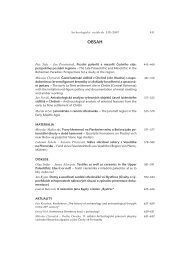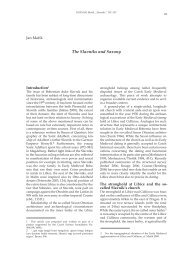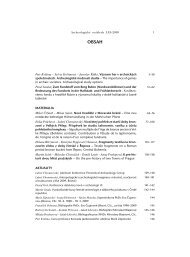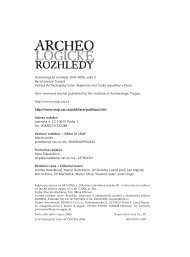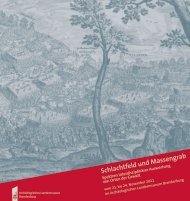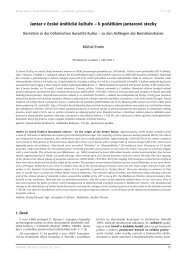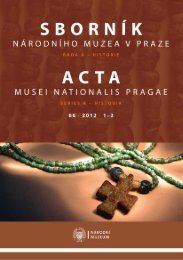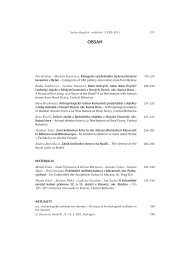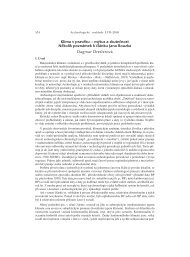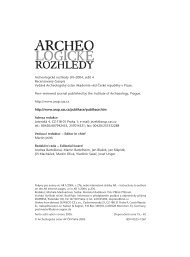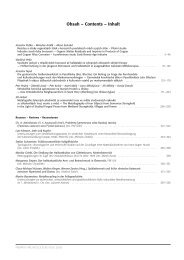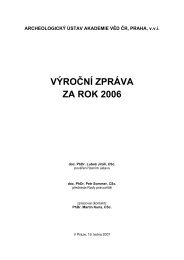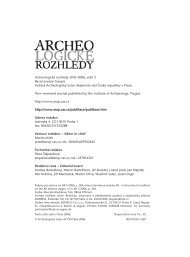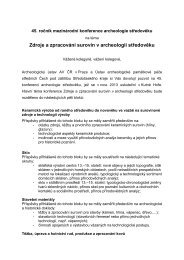2003_2 - Archeologický ústav AV ČR
2003_2 - Archeologický ústav AV ČR
2003_2 - Archeologický ústav AV ČR
Create successful ePaper yourself
Turn your PDF publications into a flip-book with our unique Google optimized e-Paper software.
296LIKOVSK¯ – DRDA: Epidurální krvácení na lebce ...surface of cerebral cavity of the skull Ao 7797. In several parts alterations are observable whichcould be considered as implying the healing processes (fig. 7).The defect of internal surface of frontal bone had been very probably caused by breaking outthe internal lamina under the location of strokes with subsequent epidural hemorrhage (Tesař 1984)with the injured diploë in itself being probably the source of bleeding. Based on signs of healing,the survival over at least several days or better weeks after suffering the injury would be supposed(Bednář et al. 1984). However, sharp fissures on the external lamina of the frontal bone withoutclear signs of healing give evidence against a prolonged survival time period.From the clinical point of view, it is possible to assume the development of unconsciousness dueto cerebral concussion or contusion and after elapse of several hours or even days, the coma causedby compression of cerebral structures with the growing hematoma (Macek et al. 1973). An intervalof normal consciousness between the injury and onset of symptoms is observable with one third ofpatients, and approximately for two thirds of affected persons it lasts up to 6 hours (Böhm 2002).However, with the mere finding of craniocerebral lesion it is not possible to do any conclusionsabout the immediate cause of this man’s death. Although this lesion is considered as perilous to life,another injury of soft tissues or post–cranial skeleton might immediately cause the death. This ishowever difficult to decide because nothing except the skull is preserved to become the object ofour study. The finding of intracranial hemorrhage in the cranium Ao 7797 of Závist not only increasesthe number of known palaeopathologic findings of intracranial hematoma but also representsfurther example for usefulness of endoscopic examination in the palaeopathologic diagnostics.Comparison with knowledge coming from the palaeopathologic study of numerous collectionof human skulls and their fragments from Manching oppidum shows many conformities with ourfinding. Between the skulls of Manching with traces of violent acts, the majority belongs to youngmen. Recorded documents give evidence for considering them to be due rather to duels betweenindividual rivals than to massive battle combat. Survival and complete healing of severe injuries werefound only in several rare cases. Generally the skulls do not have the mandibula which had beenperhaps removed at the time of separation of head from body. The meaning of trophies or relics isassigned to a part of these skulls. In several cases, the later deposition of skulls into pits shows specialfeatures. Possible connection between the deposited human residues and near–by noted buildingsis considered (Lange 1983, 97–102, 106–109; Hahn 1992, 229–232).The separation of heads is a practice, which was in the Celtic world recorded already in works ofantique authors (Strabo, Poseidonius, Diodorus Siculus: Cougny 1986, 72, 374, 407). It belongs intothe ritual sphere typical for the military élite. This practice is supported by many archaeological findingsin various settings (Brunaux 1996, 48, 93–94, 151–154). The skull of Závist and its incidenceundoubtedly corresponds well with the analogous phenomena. The observed post–traumatic stateof the injured man in this specific case may bring the evidence for the decapitation which did notrepresent the mode of killing but rather the gesture of taking the head off the already dead body asa trophy or relic. Unanswered remains the question whether the head belonged to a defeated rivalor to a problematical victor.English by Václav ŠtěpánJAKUB LIKOVSKÝ, <strong>Archeologický</strong> <strong>ústav</strong> <strong>AV</strong> <strong>ČR</strong>, Letenská 4, 118 01 Praha 1; likovsky@arup.cas.czPETR DRDA, <strong>Archeologický</strong> <strong>ústav</strong> <strong>AV</strong> <strong>ČR</strong>, Letenská 4, 118 01 Praha 1; drda@arup.cas.cz



